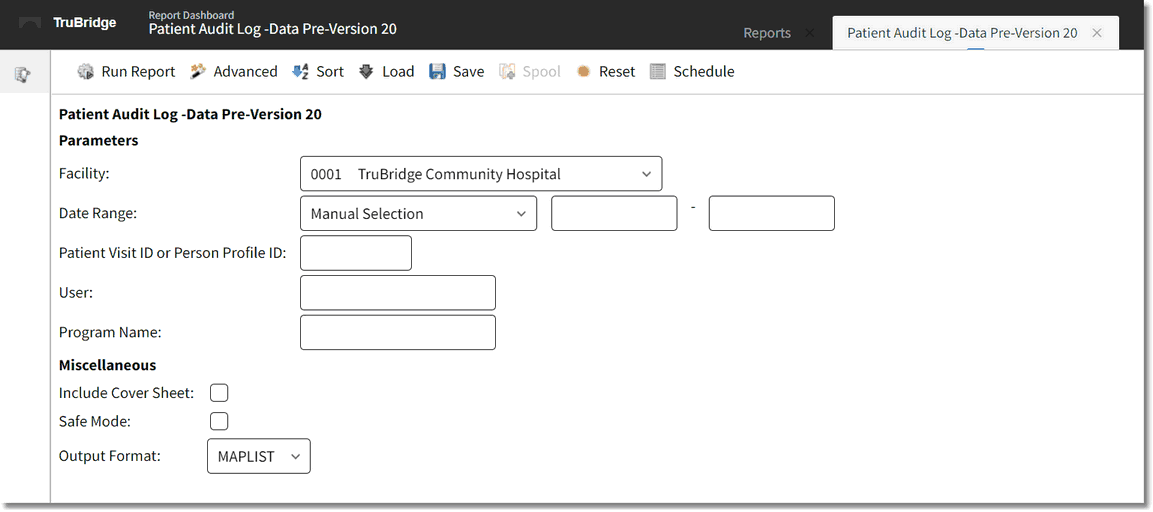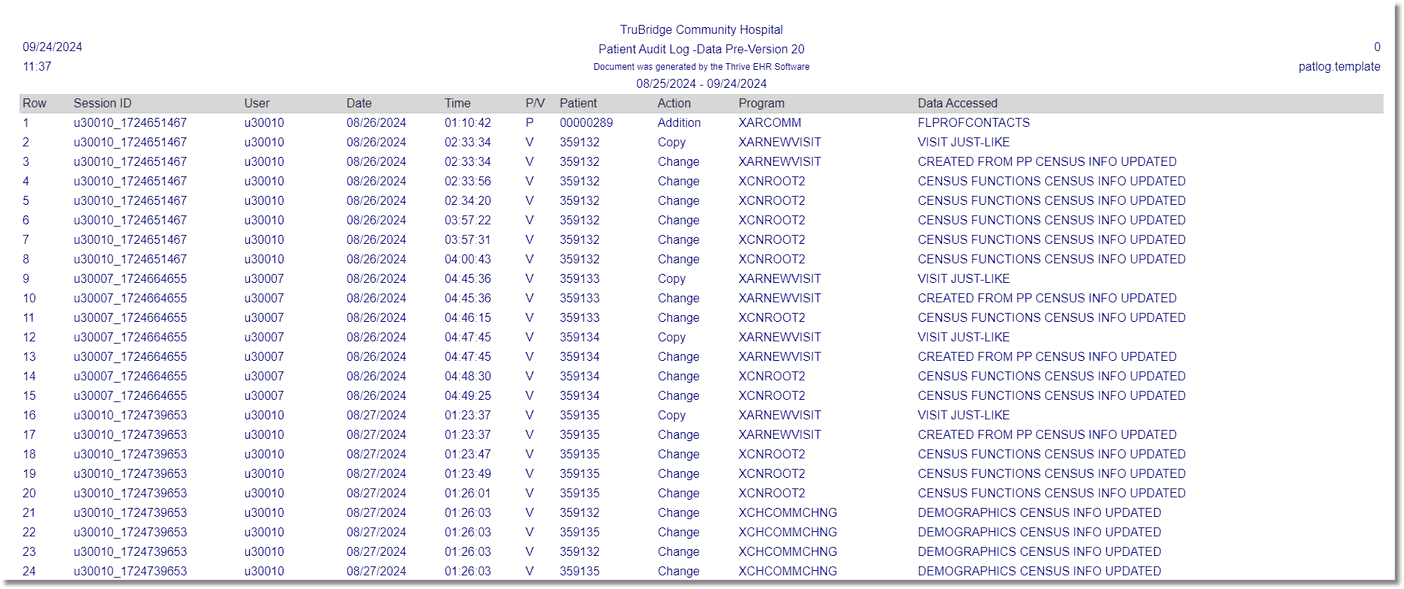|
<< Click to Display Table of Contents >> Patient Audit Log - Data Pre-Version 20 |
  
|
|
<< Click to Display Table of Contents >> Patient Audit Log - Data Pre-Version 20 |
  
|
The Patient Audit Log -Data Pre-Version 20 will display audit data that occurred prior to the installation of Version 20. For audit data after the Version 20 installation, please see the Patient Audit Log. This audit log is used to help protect the electronic health record and to conduct or review a security risk analysis. It is also used to implement security updates as necessary and correct identified security deficiencies as part of its risk management process.
To meet this objective, the facility must be using Linux, UBLs, Encryption, Patient Audit Log and Break the Glass functionality, which is supported by Point of Care.
NOTE: In order to preserve disk space, Patient Audit Log data older than three months will be compressed and archived by TruBridge. If needing to view data older than three months, please contact TruBridge Technical Support to uncompress and restore the data.
Select Web Client > Report Dashboard > Patient Audit Log

Patient Audit Log Parameters
•Facility: Select the desired facility to view audit information.
•Date Range: Enter the desired date range to view audit information. When the date is entered as MMDDYY, the system will automatically change it to MMDDCCYY format.
•Patient Visit ID or Person Profile ID: Enter the desired patient account number or profile number to pull to the Patient Log.
•User: Enter the employee or physician login.
•Program Name: Enter the program name (launcher name) to see audit data for that program name only. If this field is left blank, the report will run for all program names.
•Include Cover Sheet: Select this option to have a cover sheet pull with the Date and Time the report was run, User, Facility, Date Range of report and Section.
•Safe Mode: Select this option if the report would not build due to bad data being in a field. If the report has bad data, a message will appear stating to run report using the Safe Mode. If selected, Safe Mode will replace all of the bad characters with a ?. This will allow the intended report to generate. The bad data may then be seen and may be corrected from the account level.
•Output Format: Use the drop-down box to select one of the following report Format options:
▪HTML
▪XML
▪CSV
▪MAPLIST
▪TXT
Patient Audit Log

Patient Audit Log -Data Pre-Version 20 Report
Listed below is an explanation of each column.
•Row: Sequential number for the action
•Session ID: A unique identifier assigned to each user at the time of login and remains with the user until he/she logs out. The purpose of the Session ID is to make it easier to trace through an auditing scenario.
•User: Pulls the employee login
•Date: Pulls the date an action occurred
•Time: Pulls the hour, minute and seconds an action occurred
•P/V: P indicates the number in the Patient column is the Profile number. V indicates the number in the Patient column is the Visit number.
•Patient: Pulls either the Profile or Visit number.
•Action: Pulls one of the following actions that occurred
▪Query: Area was accessed but not updated
▪Change: Area had information that was updated
▪Addition: Area had information that was added
▪Discl (Disclosure): Information was sent to another area via interface
▪Delete: Area had information that was deleted
▪Print: Report was printed containing the patient account number
▪Copy: Information was copied from certain areas within the system. The Data Accessed column will show when one of the following has taken place on an account or profile:
oCOPY MAMMO PROFILE
oCOPY REPORT DIST SETTINGS
oATTACH ORDER TO TRANSCRIBED ORDER
oMDS JUST-LIKE
oEFORM COPY FORWARD DATA
oFLOWCHART COPY PERTINENT HISTORY
oPROFILE MASS CHANGE
oCRITICAL ACCESS SPLIT
oDEMOGRAPHICS CREATE FAMILY MEMBER
oVISIT JUST-LIKE
NOTE: If the acronym EA precedes the action description, then that action was performed using the Emergency Access to EPHI feature. For example, EA Query, would mean that an area was accessed but not updated after Emergency Access was granted on the account.
•Program: Pulls the program name.
•Data Accessed: Pulls the description of what was accessed on the patient account
NOTE: Entries in the EPHI Audit Log can only be made by successfully authenticated users authorized by the facility to access electronic health information stored in Thrive. Mechanisms and triggers have been designed to detect if the Audit Log has been accessed, modified or otherwise tampered with from outside Thrive. When a tampering event has been detected, notifications are sent to TruBridge via Remote Communications, and sites will be informed regarding the status of the audit log. For more information regarding this, please contact TruBridge Software Support.